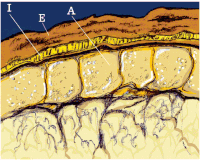
Photo from wikipedia
Novel aleurone-rich wheat milling fraction developed and produced on industry scale is investigated. The special composition of the novel flour with high protein, dietary fiber and fat content results in… Click to show full abstract
Novel aleurone-rich wheat milling fraction developed and produced on industry scale is investigated. The special composition of the novel flour with high protein, dietary fiber and fat content results in a unique combination of the mixing and viscosity properties. Due to the high lipid concentration, the fraction is exposed to fast rancidity. Dry heat (100°C for 12min) and hydrothermal treatment processes (96°C for 6min with 0-20 L/h steam) were applied on the aleurone-rich flour to modify the technological properties. The chemical, structural changes; the extractability of protein, carbohydrate and phenolic components and the rheological characteristics of the flours were evaluated. The dry treated flour decreased protein and carbohydrate extractability, shortened dough development time, reduced gel strength and enhanced the gelling ability. Hydrothermal treatment caused changes in the phenolic content improved the dough stability and -resistance. Heat treatment processes were able to extend the stability of the flour.
Journal Title: Food chemistry
Year Published: 2017
Link to full text (if available)
Share on Social Media: Sign Up to like & get
recommendations!